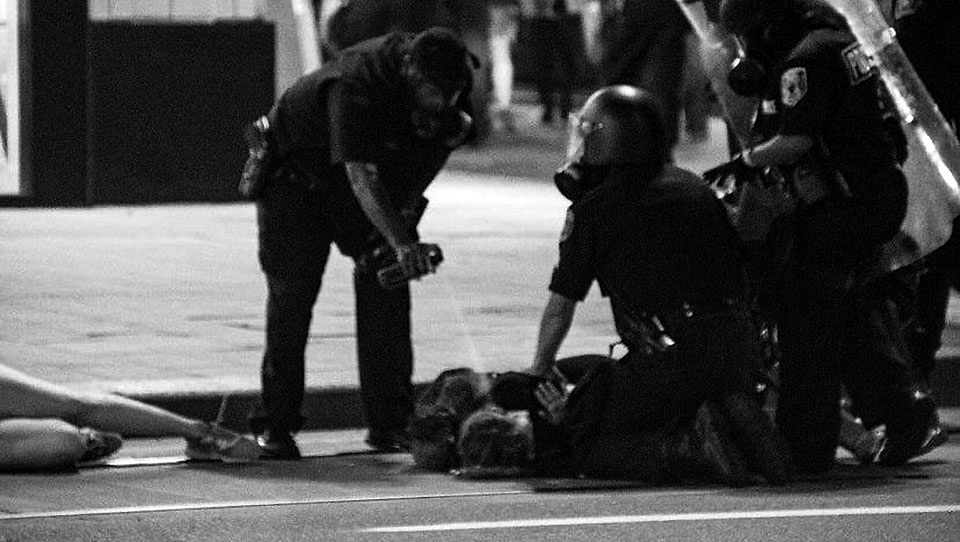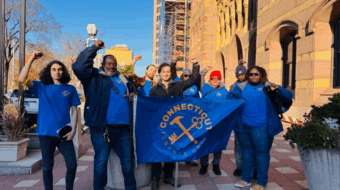
DETROIT—On March 8th, at a formal session, Detroit’s City Council unanimously voted to approve $2,000 retention bonuses for every “active member” of the Detroit Police Department as well as $1,000 to all police assistants of the Detroit Police Officers Association.
“In Detroit, there’s no talk of defunding police; we want to put more money behind our officers, and this is a clear statement of that today,” Mayor Mike Duggan said.
There was immediate backlash from around the city as citizens and activist groups were quick to note that these bonuses were, at least in part, being paid out of emergency ARPA funds that Detroit residents have been demanding to be spent on home repairs and intergenerational poverty. As Police Chief James White pointed out, this “initiative will be paid for by federal American Rescue Act funds, the city’s General Fund and money that was allocated for overtime.”
Although the mayor has approved funds for areas citizens were most concerned with, the majority of the ARPA funds are being allocated to infrastructure and IT investment, jobs, landlords, and blight removal. $50 million is being allocated to public safety (which includes the DPD), which should be contrasted to the mere $7 million allocated to affordable housing services.
Seven of the $50 million allocated for public safety is going to ShotSpotter – a technological system made up of microphones and sensors that can identify gunfire within an 82-foot radius. The technology has yielded results; however, the DPD has been reluctant to release any statistics around the effectiveness of ShotSpotter in use alongside Project Green Light — the city’s public-private surveillance system — and facial recognition technology that was purchased back in 2017.
According to a recent episode of Detroit-based podcast Tracked and Traced, due to an agreement between the city and ShotSpotter, “no police or city officials know exactly where the microphones and sensors are located.” Despite the DPD’s claims that violent crimes have decreased since ShotSpotter was implemented, the “police have provided little evidence to back up that claim….DPD has not responded to a Freedom of Information Act request for the total number of ShotSpotter alerts they received and the number of officer deployments based on those alerts.”
Detroit’s Police Department has been under the microscope lately as non-violent gun charges have dramatically increased since the pandemic began in 2020. Data showed that 32 out of 33 people prosecuted for concealed weapons charges were Black. Advocacy groups such as Detroit Will Breathe along with public defenders called upon Wayne County Prosecutor Kym Worthy to drop all concealed weapon related charges based on this data.
Another point worth noting is that in the fall of last year, the Detroit Justice Center released arrest statistics for the entire metro Detroit area which showed not-so-surprising racist results, exposed the inflated budgets of several police departments surrounding the city, and pointed out some disturbing statistics around how many people with disabilities are killed by police every year.
After the previous week’s vote on the retention bonuses, several citizens called into the formal session on the 15th to voice their discontent with the decision.
Two other line items concerning the police and crime in the city were on the agenda as well: one which regarded allocating funds to the Real Time Crime Center — as well as creating “new, mini RTCCs — and the other was for a grant for Community Based Crime Reduction research.
The DPD’s RTCC was originally built in 2016 – the same year that Project Green Line came to the city – and has been expanding its reach with so-called mini RTCCs in other precincts.
Detroit is not the first
Detroit is not the first city to have one of these high-tech command centers, New York City and New Orleans also have them, and they’re becoming more and more prevalent around the country as predictive analytics are becoming commonplace and the norm of policing.
The proposal to allocate the extra funds to the Real Time Crime Center was postponed until the next formal session on March 22nd. Council Member Gabriela Santiago-Romero asked for it to be postponed another week and has been quite public that she will be voting “no” on the resolution, in effect, as she said during the meeting “to make sure…we are not policing are way out of crime, and that we are actually working toward solutions that address the root causes of crime.”
Council Member Santiago-Romero spoke with People’s World recently about the RTCC and the current state of policing in Detroit.
“We asked the DPD to send data around the reduction in gun violence and how they determine that reduction. All the data received was around ShotSpotter and Green Light, and we are seeing trends in violence go down but given how faulty and expensive these technologies are, it’s not at the rate I would expect. The mayor wants to put $7 million into ShotSpotter and I don’t see the point if we don’t have enough police on the streets to respond to gunshots.”
“Our safest communities don’t have ShotSpotter — they don’t have the technology that endlessly surveils their people. We need to be focused on investing in solutions that address the root cause of crime, which studies have shown are poverty, mental health issues, and homelessness. The bigger concern is that as people are surveilled, there are those who are wrongly accused and one person wrongfully accused is too many.” She added.
Since the fervor of the summer of 2020, it appears people are more comfortable with voicing slogans such as “ACAB” and “Defund/Abolish the Police.” Whether or not they fully identify or even believe in such possibilities is another question altogether. The more imminent question is then “who wants more cops on the streets?”
“If someone breaks into your home, you’re going to want someone to show up – and I’m thinking about seniors here. What I hear from seniors is that when they call the police, they don’t show up. These people hear gunshots, they see people being murdered on their block, and they’re not seeing the police respond. If we’re trying to address violent crime, then I think we should be meeting our current needs,” said Santiago-Romero.
When asked about the Crime Reduction research grant, Santiago-Romero says that she hopes “we are looking into alternative ways of policing….and looking to not invest in technologies but to invest in people.”
Finally, we discussed the infamous vote to grant retention bonuses, totaling $5 million which in part is coming from emergency ARPA funds allocated to the city.
“I was not told it was coming from ARPA funding. When I was approached by the police department, I asked if this was going to come from ARPA and they told me they were going to use the money from the vacancies — which would come from their own budget — in order to retain their current police officers. The problem is we can’t seem to hire new officers and we are losing current police to the suburbs — we are losing money double time,” the council member explained.
“What I’m being told now is that it’s coming from both their internal budget and vacancies and only a small portion is coming from ARPA, ” said Santiago-Romero. “Had they told me it was coming from ARPA, I would have voted no.”
Intended to retain
“I did it with the intention of retaining police officers. I want to support people — police are people, they are workers. I want them to be cared for and they’re leaving,” she added. “However, if we’re giving police a one-time bonus, why can’t we do the same for our retirees?”
When asked why we can’t afford to pay our officers competitive wages to keep them from going to the suburbs, Santiago-Romero responded: “That’s my question for the DPD — they have the biggest budget out of any department.”
Although the recent events at the city council meetings — retention bonuses being unanimously approved, funds for the RTCC being voted on, etc. — inspire a familiar mixture of anger and hopelessness; the situation is not necessarily beyond saving.
Narratives around accountability or more training tend to proliferate in discussions when defunding police departments comes up — and not simply as possible compromises, but because “defunding” or “abolishing” the police is presupposed as unrealistic idealism. Despite the dominance of this ideology, the truth today seems to point at something different.
As Gabriela Santiago-Romero remarked during the last City Council meeting, the focus should be on “reimaging community safety.”
Retaining police officers, in a word, certainly goes against any possible notion of abolishing the police; however, the situation we find ourselves in today, not retaining police officers opens up a larger budget for technological weapons and surveillance to fill that gap. So, what are we to do when stuck in such a deadlock? Do we learn to once again trust and live with the police — taking a humanist, “police as people” approach — or do we maintain the abolitionist energy allowing for the ubiquitous Eye of the public-private surveillance system to thrive?
Part of what occurred in and after the summer of 2020 around the globe was revealing that this “deadlock” is utterly false. What if instead of reading police departments’ efforts simply as more of the same expansion of power, we read the fleeing police force and the calls for more funding for private-based technologies as “the morning after” — as the results of a disruption that has caused a displacement of that very power? What if the room for change was already opened up a couple of summers ago and what we’re witnessing is a series of frenzied acts to fill that gap? What if the clock on the project of a revolutionary shift in community safety has already started ticking?
This is not a call for reform and this is not a call for more “realistic” measures — far beyond that, we need to retain some fidelity to the mass mobilizations in Anaheim in 2012, Ferguson in 2014, St. Louis in 2017, and the international protests of 2020 — to name only a few.
Such a reading of our current, “concrete” conditions suggests police power is in crisis: the focus on results-based policing — i.e. more arrests, more convictions — appear to be efforts of gaining more visibility of effectiveness rather than effectiveness in any sort of actual way. This seems to both create the appearance of crime reduction and ensures job/funding security for the police — which can be understood as an attempt at a self-enclosed cycle of policing. Such a cycle is not simply more of the same, but the creation of a new, “objective” setting for where crime takes place — a fully visible, unquestionable frame of policing that both deters crime and ensures its criminal in advance.
This reading of today also means we need to state the particulars of our demands. This means we are to consider less rhetoric around notions of accountability and more on political intervention to question the very need of having someone with a firearm at a traffic stop; more focus on creating proposals around creating minimal funding for departments that would focus on responding to car accidents, mental health calls, etc.
If the problem is one of trust — both that of the police and of someone to respond — then the solution ought to stem from the very lack of trust rather than what that trust once was.
It cannot be about waiting on police departments to disappear first but to focus on the most possible “impossibilities” — pushing government bodies like the city council to consider legislation which would establish departments that remove such “responsibilities” from the police’s jurisdiction, begin to recognize community-based groups that can handle the “policing” of their neighborhoods, and even restrict when police are allowed to even have firearms on them — is precisely where we must begin again.









